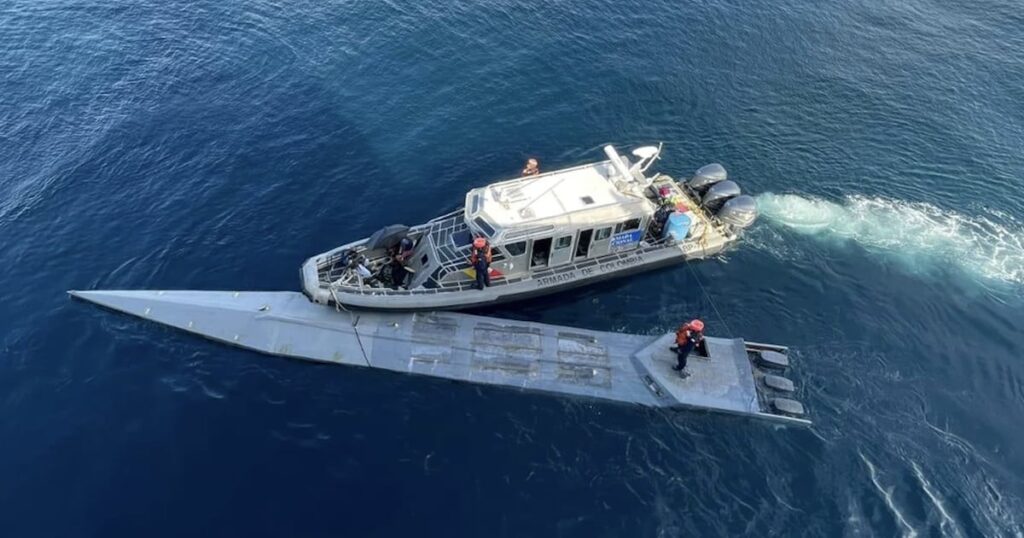
An unmanned narco submarine outfitted with a Starlink antenna has been intercepted by the Colombian Navy, marking a significant breakthrough in the fight against drug cartels. The semisubmersible, found off the Caribbean coast near Santa Marta, was not carrying drugs at the time of its capture. However, authorities and Western officials in Colombia suspect it was a trial run orchestrated by a notorious drug cartel.
The vessel, equipped with a satellite dish from Elon Musk’s SpaceX, was believed to be a test by the Gulf Clan, a prominent drug trafficking organization. According to the navy, the submersible could potentially transport up to 1.5 tons of cocaine. “It was being tested and was empty,” the navy informed AFP on Wednesday, underscoring the growing sophistication of drug smuggling operations.
Technological Advancements in Drug Trafficking
This incident highlights a troubling trend where drug cartels are increasingly leveraging advanced technology to evade law enforcement. The use of Starlink terminals in illegal operations is not unprecedented. In November of the previous year, Indian authorities intercepted an unmanned vessel loaded with $4.25 billion worth of methamphetamine. This vessel was remotely navigated using Starlink technology in the remote Andaman and Nicobar islands.
Starlink, a creation of Elon Musk’s SpaceX, employs low-orbit satellites to provide internet connectivity in remote areas. While this technology is intended to bridge the digital divide, its misuse by criminal organizations poses new challenges for global security forces.
Implications for Law Enforcement
The capture of the Starlink-equipped narco sub underscores the evolving tactics of drug cartels, which are increasingly turning to automation and technology to enhance their operations. According to security experts, this development represents a significant escalation in the technological arms race between law enforcement and criminal enterprises.
Dr. Maria Gonzalez, a security analyst specializing in Latin American drug trafficking, noted, “The use of such advanced technology by cartels indicates a shift towards more sophisticated smuggling techniques. This presents a new set of challenges for authorities who must now adapt to counter these high-tech threats.”
Historical Context and Comparisons
The use of semisubmersibles in drug trafficking is not new. For decades, cartels have employed these vessels to transport illicit substances across international waters. However, the integration of satellite technology into these operations marks a significant evolution. Historically, drug traffickers relied on stealth and manual navigation to evade capture. The advent of remote-controlled, satellite-guided vessels could potentially revolutionize the logistics of drug smuggling.
“The integration of satellite technology into drug smuggling operations is a game-changer. It allows traffickers to operate with greater precision and less risk of detection,” said Dr. Gonzalez.
Future Challenges and Strategies
As drug cartels continue to innovate, law enforcement agencies worldwide must develop new strategies to combat these threats. The Colombian Navy’s recent success demonstrates the importance of international cooperation and intelligence sharing in addressing the global drug trade.
Moving forward, authorities may need to invest in advanced surveillance technologies and develop specialized units trained to intercept and neutralize high-tech smuggling operations. Additionally, partnerships with tech companies like SpaceX could prove invaluable in preventing the misuse of cutting-edge technologies.
The capture of the narco sub is a reminder of the ongoing battle against drug trafficking and the need for constant vigilance and adaptation. As cartels continue to push the boundaries of technology, law enforcement must remain one step ahead to protect communities and uphold the rule of law.
The Colombian Navy’s operation serves as a critical warning and a call to action for global security forces. As the fight against drug trafficking enters a new technological era, the stakes have never been higher.





